Hand-hygiene systems provide compliance help
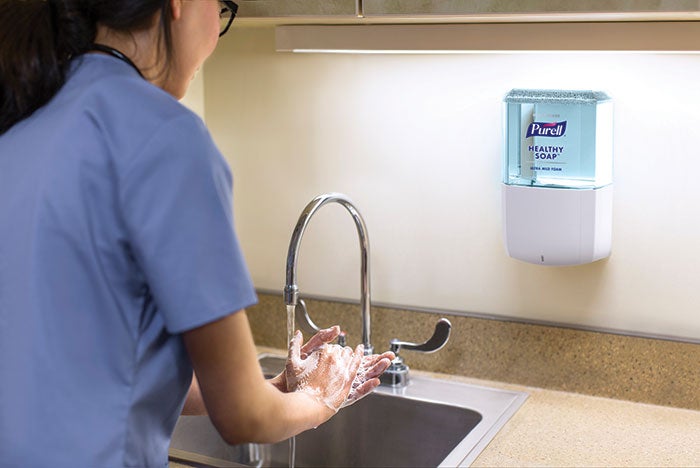
The latest hand-hygiene compliance monitoring (HHCM) systems serve as coaching tools that remind health care workers of critical hand-washing events. They also provide management with data to drive improved compliance while helping to decrease the growing number of health care-associated infections.
There has been a gradual shift toward electronic monitoring because of its ability to capture close to 100 percent of hand-hygiene events. These passive systems take no additional time out of a busy health care worker’s day and are not subject to human error or manipulation.
“Combined, HHCM system providers are at less than 10 percent market penetration. This is largely because the category is new and typically not budgeted for. Also, many clients have been waiting for direction and a contract award announcement for this category from their group purchasing organizations, which recently happened via two of the largest national players, Premier and HealthTrust Purchasing Group,” says Brent D. Nibarger, chief client officer, Biovigil Healthcare Systems Inc., Ann Arbor, Mich.
Allison Pearsall, senior product manager, DebMed (part of SC Johnson Professional), Charlotte, N.C., estimates that less than 5 percent of acute care facilities are using electronic HHCM systems today; however, that number is growing as the success stories become better known and understood.
Another reason for their growing use is the fact that the Centers for Medicare & Medicaid Services recently added Clostridium difficile infections as a reportable condition along with methicillin-resistant Staphylococcus aureus infections. “Both of these conditions are believed to be related to contact transfer via the hands. This is prompting renewed interest in tools and practices that can help prevent these infections,” Pearsall says.
Greater acceptance
In recent years, HHCM systems have enjoyed greater acceptance among clinicians along with nurses and other health care workers. “Initially, clinicians were apprehensive about being ‘tracked’ and felt there was a Big Brother aspect to automated monitoring. But as the benefits of electronic monitoring have come to light, compliance and acceptance has increased dramatically,” says Adam Peck, vice president of marketing, CenTrak Inc., Newtown, Pa.
Today’s HHCM systems are used more for coaching and prompting, as opposed to punishing people for noncompliance. For example, Biovigil’s system reminds users to perform hand hygiene if and when needed, and visually demonstrates that it is performed. “No aspects of the system are punitive in nature unless a hospital chooses to create such policies, which we have not seen any support for. In fact, what our clients experience is that once they reach full adoption, everyone using the system operates at a 97-plus percent compliance level,” Nibarger says.
The Ecolab Compliance Monitoring System produces individual reports, showing where and when an employee is or is not missing hand-hygiene opportunities. “Our customers say they like to use the system more as a carrot than as a stick, and we have found these facilities are averaging 90 percent compliance,” says Kathleen Burzycki, senior marketing manager and global program leader, Ecolab, St. Paul, Minn.
Gojo Industries Inc., Akron, Ohio, offers a system designed to educate health care workers on the importance of hand hygiene and provide an accurate picture of performance. The company’s Smartlink solutions offer clinician-based support, a service by which clinicians are deployed at a hospital to help with the education and rollout of the system.
“One of the first steps is to understand a hospital’s culture. The clinician then works within that culture to influence behavior by providing coaching to ensure that staff are complying with the guidelines,” says John Lerner, Smartlink Solutions business development vice president.
Proventix Systems Inc., Birmingham, Ala., focuses on hand-hygiene behaviors in patient care areas. “Allowing hospitals to drill down into areas for pathogen-specific processes — including mid-episode washes, caregiver rounding display and operating room surveillance — are part of our expanding service,” says John E. Lee III, president and chief operating officer.
Data collection is key
Data collection is a key feature of the latest HHCM systems because the information can be used to analyze past performance and improve on future compliance. In fact, having access to accurate data to effectively measure and improve hand-hygiene performance is critical to the success of any program.
Ecolab’s system displays dynamic data on a dashboard and provides push reports for managers to see how their departments are performing. Giving individuals report cards gives them more ownership over their behavior and shows them where there is room for improvement. In addition, data on product and dispenser usage helps management to understand the best locations for dispensers. The system automatically fills dispensers when they are low.
Gojo’s system uses data analytics to identify a performance baseline and to measure the impact of interventions and behavior-change techniques. Customizable reports allow the data to be analyzed from many different angles. For example, hourly performance data can provide insights for nurse managers that could lead to reminding staff to perform hand hygiene during busy hours of the day.
Facilities professionals should be concerned about the footprint of electronic monitoring systems, how easy it is to integrate the technology into existing hand sanitizer and soap dispensers, and whether the systems require integration with the information technology (IT) infrastructure, according to Pearsall. “The DebMed System is not integrated into the hospital’s IT infrastructure. All dispensers are monitored and the data is transmitted wirelessly, without using Wi-Fi, to an off-site server. Users log on to a website to view their reports or the reports are emailed to them.”
Proventix Systems Inc. uses a low-voltage wired system to ensure consistent data flow on the front end and a high level of data collection. “Battery-operated systems can underperform when batteries are low. The Proventix nGage Reporting Suite is available via a secure website for all users, driving change where hand washes are missed during patient care and providing consistency in patient rounding and infection trending by source,” Lee says. “Also, the data included in the nGage system allows hospitals to recognize changes in nursing workflow and time-efficiency variations.”
Other features
The latest HHCM innovations incorporate the aforementioned data-gathering and analytical capabilities. Among recent introductions to the health care market, DebMed has unveiled version 2.0 of its electronic HHCM system. It features enhanced compliance reports, optimized navigation and an easy-to-read dashboard that automatically generates reports when users log on to the website.
CenTrak’s HHCM system can be used as a stand-alone solution or as part of its enterprise location services platform in which data can be viewed at the hospital, department or individual level.
CenTrak staff badges leverage a real-time locating system (RTLS) to communicate with dispensers and automatically collect compliance data. This information shows how health care workers are washing their hands in comparison to hospital hand-hygiene protocols. Failure to comply with these protocols results in a gentle reminder from the staff member’s RTLS-enabled badge.
The HHCM solution from Stanley Healthcare, Waltham, Mass., is part of its AeroScout enterprise RTLS platform and features hand-hygiene-specific dashboards in a MobileView visibility platform. Caregivers wear Wi-Fi badges that identify them in the system, along with two receivers — one for ultrasound, one for low frequency — to capture room entrances/exits and the use of hand sanitizer dispensers, respectively. Patient rooms and other relevant areas are equipped with an ultrasound exciter to record each instance that the caregiver enters or exits. This creates hand-hygiene opportunities when caregivers are expected to clean their hands.
“MobileView Analytics dashboards provide easy visualization of the data with the ability to drill down into different locations or times to understand trends and training opportunities,” says Sagi Geva, director of acute care solutions, Stanley Healthcare. “In addition, we created a leaderboard that shows individual results on a unit in near-real time, which creates healthy competition and drives caregivers to improve compliance.”
Ecolab has introduced a monitoring system that measures hand hygiene within an electronically monitored zone that can be created around a patient bed, stretcher or crib. A badge uses both lights and sounds that alert health care workers to the state of their compliance. The system can monitor compliance by individual, department, shift or the entire facility.
Biovigil recently unveiled its 5.0 platform, which offers a new base station and user badge that is 50 percent smaller and has features such as wireless user pairing, vibration mode, LED indicator and in-room World Health Organization (WHO) five-moment tracking. In addition, a cross-contamination feature and user alert for isolation rooms ensures that health care workers wash their hands with soap and water upon exiting a C. difficile room.
Clean Hands Safe Hands, Atlanta, offers a natural language voice reminder within its HHCM system that gently reminds clinicians to wash their hands. “We’ve seen in numerous clinical trials that a human voice does a much better job of cutting through the clutter of hospital lights and alarms than a beep or a light on a clinician’s chest,” says Chris Hermann, founder and CEO.
The company’s adaptive room modes customize the system for rooms where patients have special needs. In C. difficile rooms, the voice reminds clinicians to use soap and water only, and it can be configured to only give credit for soap usage. In isolation rooms, the system gives clinicians more time to don gowns and gloves. It also features a mute button for rooms where there’s an end-of-life situation or where the patient’s care needs require silence.
Clean Hands Safe Hands also offers a six-phase hand-hygiene acceleration pathway that helps hospital teams to achieve continuous improvement in a way that easily adapts to different cultures. The phases build upon each other in a gamified approach.
The near future
Peck foresees continued efforts to fully integrate electronic monitoring sensors into soap and alcohol dispensers for improved measurement of hand washing as well as the amount of cleaning product that is dispensed. For his part, Geva predicts future HHCM systems will more accurately monitor the WHO five moments and identify the correct opportunity when hand hygiene is required, thus ensuring more accurate hand-hygiene compliance rates for busy clinical staff.
Neal Lorenzi is a freelance writer based in Mundelein, Ill.
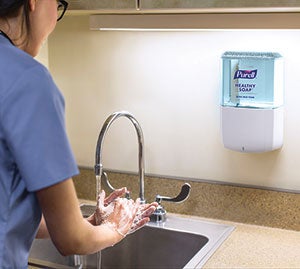
Double duty
Purell ES8 dispensers can be integrated with Smartlink via plug-in modules to track hand-hygiene performance and receive automatic service alerts. Gojo Industries Inc.

Traffic flow
This badge reminds health care workers to perform hand hygiene when needed through green, yellow and red light signals. Biovigil Healthcare Systems Inc.

Built-in solution
This HHCM system uses RTLS-enabled staff badges and cable-free monitors that are either integrated with or mounted to hand-washing stations. CenTrak Inc.
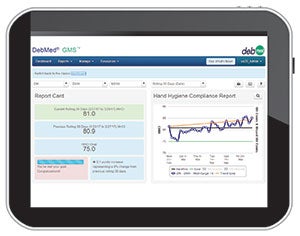
Accurate measure
The DebMed badge-free, electronic HHCM system captures 100 percent of hand-hygiene events and provides accurate compliance scores. Deb Group Ltd.

One-to-one
The interactive nGage system allows users to track individual-level compliance. Proventix Systems Inc.
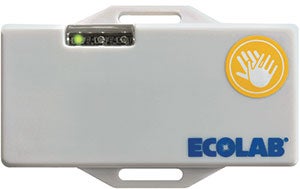
In the zone
This monitoring system features patient zones around each bed, stretcher or crib, to ensure that interactions between health care workers and patients are safe. Ecolab
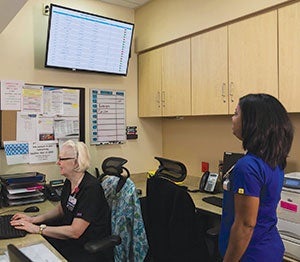
Winning strategy
A leaderboard in the nurse station shows caregivers how they’re doing relative to their peers, sparking friendly competition to improve. Stanley Healthcare

Getting personal
This hand-hygiene performance system features adaptive room modes that allow users to customize the system for rooms where patients have special needs. Clean Hands Safe Hands




